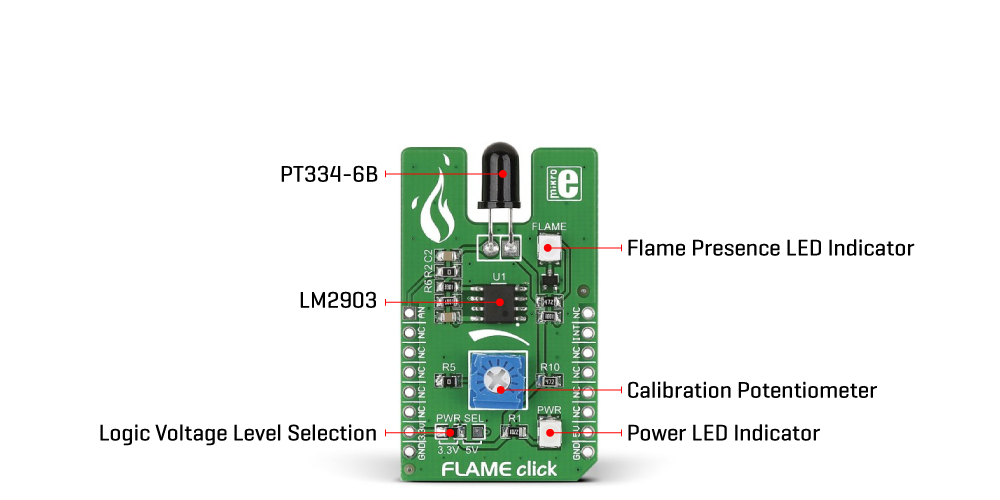19%
OFF
GO LOCAL
| Company | Stock | Price |
|---|---|---|

MIKROE-1820
26 g
Status:
Flame Click is a compact add-on board providing a fire detection solution. This board features the PT334-6B, a silicon phototransistor covered in black epoxy sensitive only to infrared light from Everlight Electronics. Based on a phototransistor, this flame detector has a faster reaction time than smoke or heat detectors, which can identify smokeless liquid and smoke that can create open fire. Communicating with the host MCU through the analog mikroBUS™ line, the Flame Click also comes with a small potentiometer to set up the exact detection threshold for a fire alarm. This Click board™ is suitable for a variety of security applications for detecting and responding to the presence of a flame.
Flame Click is supported by a mikroSDK compliant library, which includes functions that simplify software development. This Click board™ comes as a fully tested product, ready to be used on a system equipped with the mikroBUS™ socket.
This product is no longer in stock
Availability date:
19%
OFF
| Company | Stock | Price |
|---|---|---|

Flame Click is based on the PT334-6B, a high-speed and high sensitive NPN silicon phototransistor from Everlight Electronics, which detects and responds to the presence of a flame. The PT334-6B is covered in black epoxy, making it sensitive to visible and near-infrared light. Based on a phototransistor, this flame detector has a faster reaction time than smoke or heat detectors, which can identify smokeless liquid and smoke that can create open fire.

This Click board™ operates in two ways. It can output a continuous analog signal from the phototransistor to the analog mikroBUS™ line or send an interrupt to the target board MCU through an interrupt pin routed to the INT pin of the mikroBUS™ socket. Flame Click also has a small potentiometer that allows you to set the exact threshold that will trigger the interrupt and calibrate the sensor for the environment in which you’ll be using it. This will require fine-tuning as the phototransistor will be sensitive to the surrounding thermal radiation. Properly calibrated, Flame Click can be used in various safety applications. A flame alert function is also visually presented by a red LED marked as FLAME, responding to the presence of a flame.
This Click board™ can operate with both 3.3V and 5V logic voltage levels selected via the PWR SEL jumper. This way, it is allowed for both 3.3V and 5V capable MCUs to use the communication lines properly. However, the Click board™ comes equipped with a library containing easy-to-use functions and an example code that can be used, as a reference, for further development.
Type
Optical
Applications
Can be used for a variety of security applications for detecting and responding to the presence of a flame
On-board modules
PT334-6B - NPN silicon phototransistor from Everlight Electronics
Key Features
Low power consumption, high-speed, high photo sensitivity, fast response time, covered in black epoxy, calibration potentiometer, flame LED indicator, and more
Interface
Analog,GPIO
Feature
No ClickID
Compatibility
mikroBUS™
Click board size
M (42.9 x 25.4 mm)
Input Voltage
3.3V or 5V
This table shows how the pinout on Flame Click corresponds to the pinout on the mikroBUS™ socket (the latter shown in the two middle columns).
| Label | Name | Default | Description |
|---|---|---|---|
| LD1 | PWR | - | Power LED Indicator |
| LD2 | FLAME | - | Flame Presence LED Indicator |
| JP1 | PWR SEL | Left | Logic Level Voltage Selection 3V3/5V: Left position 3V3, Right position 5V |
| P1 | - | Populated | Calibration Potentiometer |
| Description | Min | Typ | Max | Unit |
|---|---|---|---|---|
| Supply Voltage | 3.3 | - | 5 | V |
| Sensing Range | 760 | - | 1100 | nm |
| Peak Wavelength | - | 940 | - | nm |
| Operating Temperature Range | -25 | +25 | +85 | °C |
We provide a library for the FLAME Click as well as a demo application (example), developed using MikroElektronika compilers. The demo can run on all the main MikroElektronika development boards.
Package can be downloaded/installed directly from NECTO Studio Package Manager(recommended way), downloaded from our LibStock™ or found on Mikroe github account.
Library Description
This library contains API for FLAME Click driver.
Key functions
Check the flame status function.
Get interrupt status.
Example Description
This application detects fire.
void application_task ( void )
{
// Task implementation.
flame_state = flame_check_status ( &flame );
if ( ( flame_state == 1 ) && ( flame_state_old == 0) )
{
log_printf( &logger, " ~ FLAME ~ rn " );
flame_state_old = 1;
}
if ( ( flame_state == 0 ) && ( flame_state_old == 1 ) )
{
log_printf( &logger, " NO FLAME rn " );
flame_state_old = 0;
}
}
The full application code, and ready to use projects can be installed directly from NECTO Studio Package Manager(recommended way), downloaded from our LibStock™ or found on Mikroe github account.
Other Mikroe Libraries used in the example:
Additional notes and informations
Depending on the development board you are using, you may need USB UART click, USB UART 2 Click or RS232 Click to connect to your PC, for development systems with no UART to USB interface available on the board. UART terminal is available in all MikroElektronika compilers.
This Click board™ is supported with mikroSDK - MikroElektronika Software Development Kit. To ensure proper operation of mikroSDK compliant Click board™ demo applications, mikroSDK should be downloaded from the LibStock and installed for the compiler you are using.
For more information about mikroSDK, visit the official page.
NOTE: Please be advised that any peripheral devices or accessories shown connected to the Click board™ are not included in the package. Check their availability in our shop or in the YMAN section below.